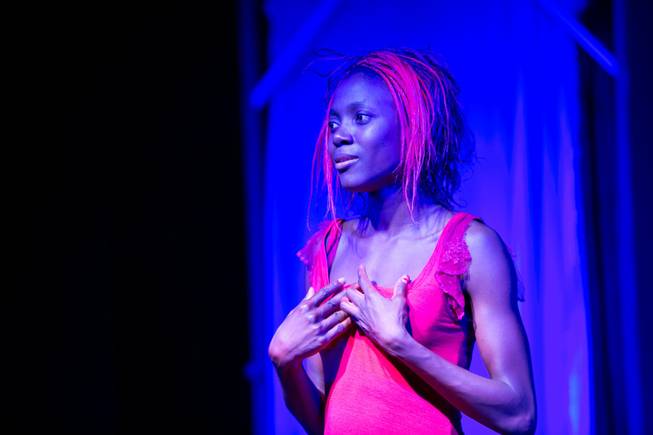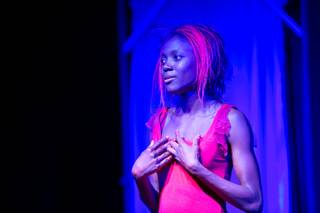
Wassa Coulibaly performs at Baobab Stage during dress rehearsals for her original work “The Red Dress” on Tuesday, Oct. 30, 2012.
Tuesday, Nov. 27, 2012 | 2 a.m.
The Details
-
- THE RED DRESS
- November 11, 17, 24 & December 1, 9, 15, 21, 23; times vary; $25
- Details and more info at Baobab Stage
- More arts and entertainment news
The cast of Cirque du Soleil’s “Zumanity” is waving to the audience at the end of its show at New York-New York, and even as the applause continues, performer Wassa Coulibaly is rushing to leave the building.
She removes the fiery plumage and beaded bodysuit of her costume — accents to the leaps and gyrations of her scintillating African tribal dance — and changes into a loose dress. Within minutes, she’s driving two miles south on Las Vegas Boulevard for a stage performance of a decidedly different kind.
Coulibaly, 35, is heading to the Baobab Stage, the theater at Town Square that she not only performs at but which she has taken over as landlord.
It is here, on a modest wooden stage built for a now-defunct murder mystery show, that the Senegal native is staging a play that at first glance stands in sharp relief against the burlesque-tinged celebration of sensuality that is “Zumanity’s” sultry hallmark.
Coulibaly’s play, “The Red Dress,” is an original work about the redemption of women forced into prostitution. It’s a story that probably wouldn’t sell to tourists on the Strip because it puts serious content ahead of spectacle. But given the integral role that sex and its industries play in the city, it’s a nonetheless astute fit for the Las Vegas community.
Indeed, while Coulibaly earns her living dancing in the polished “Zumanity,” it’s in this low-frills, 356-seat theater between a cineplex and frozen yogurt shop that she further hones her creative passions.
Twenty years ago, those passions earned her abuse rather than applause.
As Coulibaly grew up in the conservative, patriarchal Islam-based culture of Dakar, Senegal, her creative streak and flair for dance established her as an outcast and target of disparagement.
“I always felt like a misfit with my parents. ‘Oh you’re gonna be a whore. You’re gonna be this or that. Look at your hair,’” Coulibaly says, gesturing to her bright red braids and a shimmering gold dress that she designed.
To her family of white-collar professionals, dancing and art were particularly taboo, entertainment to be performed for, but certainly not by, families of their elevated class status.
“They’ve never seen success come from art. ... My style and way of expressing myself, I always had that warning,” she says. “So that was just a big, huge fear.”
Coulibaly faced that fear when she left for Hawaii in her late teens, eloping with an American whose drum playing caught her ear in the streets of Dakar. The relationship fell apart after he manipulated her into working as a stripper to earn him money, threatening her with deportation if she didn’t do what he demanded.
She escaped that relationship and found her way to Los Angeles, where she studied dance and theater at Santa Monica College. A professor recognized her unique performance style and advised her to audition for Cirque du Soleil; she was quickly hired as part of “Zumanity’s” original cast in 2003.
“In Hollywood, they told me I was ‘too African,’” she says. “I hadn’t heard of Cirque du Soleil, but the day I auditioned turned out to be the happiest of my life. They seek more than to see that you have a perfect pirouette; they seek how joyous you can be, how sad you can be and just being yourself. They put on some music and just let me dance (how I wanted) and hired me right away.”
If dancing in “Zumanity” has given Coulibaly the freedom to be herself, the semi-autobiographical “Red Dress” is catharsis from her past.
“I sat down one day and thought: What is the worst a person can be in society?” she says. “From there, can we still see beauty out of this character? And that’s what I made: bliss and this strong message told from the eye of a tramp who is this low, looked-down-to person.
“In so many ways, there is this subtleness of prostitution going on in our world, and we don’t really see it. I never was a prostitute, but yes, I ended up in a strip club and things similar because some of that is naivete and innocence, and you don’t know what you’re getting into. My purpose (with “The Red Dress”) is to show that we are born innocent and we are still innocent and there is nothing that can take that away.”
• • •
“The Red Dress” has not only opened a door into Coulibaly’s personal story. It also has plunged her into the middle of Las Vegas’ fledgling community theater movement.
For years, Strip performers such as Coulibaly sought creative outlets in casual showcases and open-mic nights at small clubs and theaters around town. But with limited space, sporadic time slots and multimillion-dollar productions to compete with, there have been few opportunities for performers’ original projects to grow beyond their nascent stages.
“The Red Dress” began as part of those showcases, evolving from a 10-minute poem her peers encouraged her to read onstage to a brief but acclaimed run as an hourlong show (then called “The Art of Prostitution”) at the 95-seat Onyx theater in 2009.
Inspired by the show’s success, Coulibaly spent the next year and a half rewriting and expanding it into a multi-act play with 15 actors that would fully realize the story she was so hungry to share. However, upon its completion, she found herself without a venue suited for its scale.
She considered the Smith Center but found the costs to be prohibitive, and she says Strip investors quickly dismissed the project.
“With (smaller scale) projects like this, you have to do it yourself, especially if you want the creative freedom,” Coulibaly says.
She was tipped off about the empty theater at Town Square and discovered an opportunity not only for “The Red Dress” but also for projects by other Las Vegas entertainers eager to expand the local theater scene.
“When I came and saw it, I jumped with joy. I loved it — the red walls, the stage, the atmosphere, everything,” she says of the Baobab Stage, which she named for a tree in Dakar beneath which people gather for music and storytelling. “I wasn’t really ready to open a theater, but because it didn’t have anything, no lights, no sound, they wanted someone to take over and run it. So I said, ‘Why not?I know a bunch of people in theater who will want to help make this happen.’”
Coulibaly quickly amassed a 20-person volunteer cast and crew from Strip shows, including “Ka,” “O,” “Love” and “Criss Angel — Believe.” Some, such as prop and design veteran Thom Rubino, were tapped specifically for their marquee-caliber talents; others, such as fellow headlining dancers and acrobats, were recruited for the opportunity to step out from behind the larger-than-life spectacle of their Strip personas.
“These are people who have something to give (beyond their shows), and that’s why I cast them. Now the challenge is, how do we articulate that?” Coulibaly says.
Though she and her peers make their living performing feats inconceivable to most audiences, learning to speak intimately before one, beneath a spotlight, has been a test of self-confidence.
“It’s easy to perform when you’re wearing a $150,000 dress under $20,000 lighting and you dance, and you know how to dance. Of course it will be beautiful,” says the play’s director and composer, J.P. Loppo Martinez. “(But) it’s not really you. It’s a performer moving, dancing. When they are here and they say their lines, they put themselves onstage ... the light, the emotion, everything has to come from your heart. It’s totally different.”
Reclining his lanky frame on a couch in the theater’s foyer, Martinez discusses the project with a zeal that at times pushes the boundaries of his Parisian-accented English; when seated before the stage and addressing the performers, however, he is judicious and precise: “Stop dancing with the words. Talk. Talk like you talk to me. Louder.”
Martinez’s guidance and expertise are among the reasons Coulibaly partnered with him for “The Red Dress” and as the theater’s general artistic director.
Martinez honed his eye for quality working with productions including Cirque du Soleil, “Le Reve” at Wynn and Celine Dion’s show at Caesars Palace, but he is eager to return to the small stage.
“I want to help show the other side of Vegas, that productions don’t have to have spectacle to have value,” Martinez says. In big-budget projects, “you lose vision and details because everyone is worried about money, which is understandable. But I think audiences are also ready for stories that speak to them, that work with the heart. And that is the big strength of Wassa’s play and what we can do here.”
Since signing a long-term lease for the theater in March, Coulibaly has spent more than 70 hours a week outside of “Zumanity” and $60,000 to remodel the space and run rehearsals.
The theater already has drawn interest from a number of local artists, including jazz societies, magicians, fellow Cirque performers and writers, eager to showcase their own work; Coulibaly and Martinez already have planned a comedy production to follow “The Red Dress,” which closes Dec. 23.
She’s also in the process of establishing the space as a nonprofit to host cultural events and provide theater and arts education classes for the community.
“We want to have a lot of variety because it’s mostly locals that come here. It’s set to be accessible, hopefully more than the Smith Center is, for people to see and create something new,” she says.
“That’s why I really want quality and theater at its best,” she says. “I want to save it for people who really have something to say. The community wants this; they’re hungry for it.”
That’s not to say money to pay for it is easily found. The production costs — in addition to lease payments on the theater — have come out of Coulibaly’s savings.
“The biggest challenge has been the spending. But we always seem to find a way,” Coulibaly says of the ever-growing list of expenses, which include copyrighting music, renovations, fire-code accommodations and obtaining a liquor license for the theater bar. “Maybe down the road we can make some of it back. But for now, this is my passion and something that I believe in, and I’m lucky that I can afford it thus far.”
Follow Andrea Domanick on Twitter at @AndreaDomanick and fan her on Facebook at Facebook.com/AndreaDomanick.

_t400.jpg?a43852d237593c63a3f872b0283e00b96c481ec7)

Join the Discussion:
Check this out for a full explanation of our conversion to the LiveFyre commenting system and instructions on how to sign up for an account.
Full comments policy